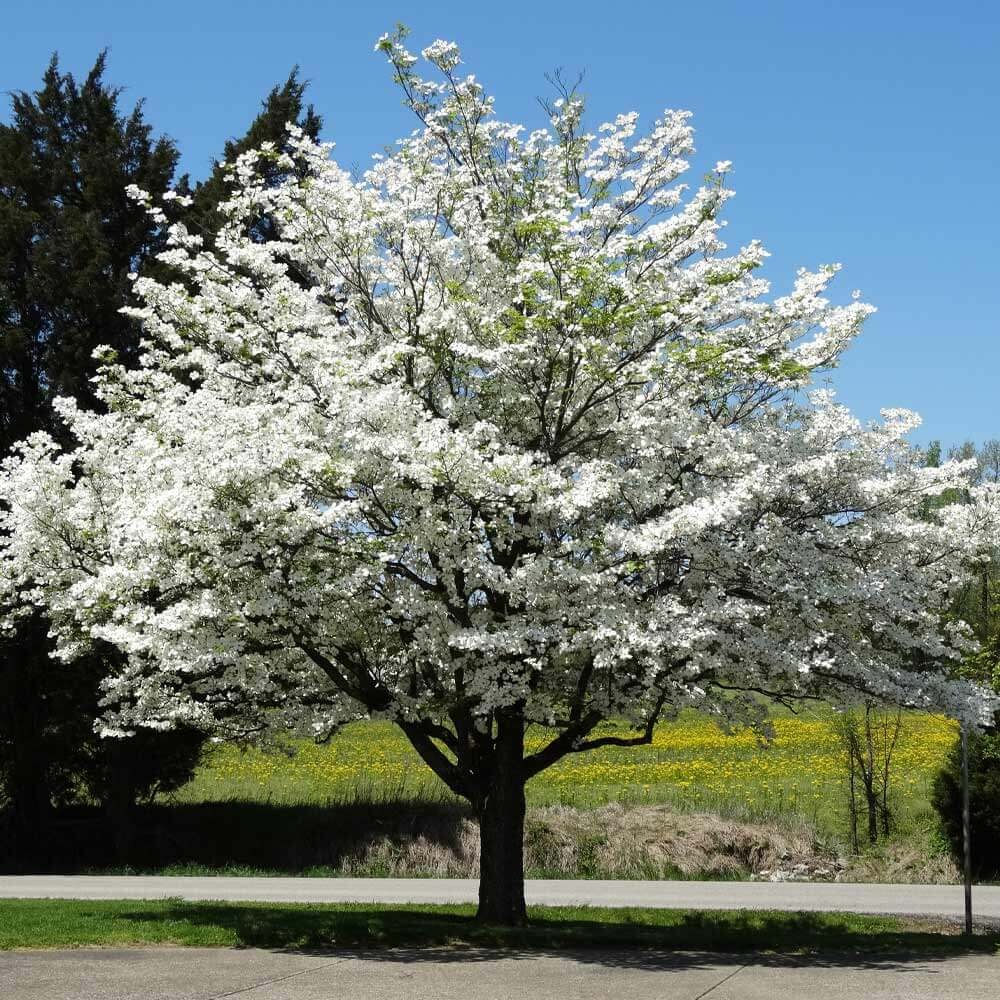Flowers of the dogwood tree, a popular decorative tree, often appear in spring and come in a range of pink, white, and red. As their name implies, these trees are indigenous to the North American continent, and you can find them all throughout the United States and Canada. The dogwood trees are popular option for landscapers and gardeners since it is simple to cultivate and needs just minimal care once it is established.
Dogwood trees are beautiful because of the magnificent blossoms that bloom on them in early spring and persist for weeks. The petals of these flowers normally number four, and their colours can span the spectrum from white to pink to red. Large, green foliage generally frame the brilliant flowers, making for a visually pleasing composition. Once the petals wither, they are succeeded by tiny fruits that resemble berries and are a favourite snack of birds and other creatures.

The Value of Regular Maintenance and Upkeep
Dogwood trees need regular care and attention to stay healthy and beautiful. The best conditions for these trees are rich, well-drained soil in full sun to partial shade during the day. Dogwood trees require regular watering to avoid stress and promote healthy growth, especially during dry years. Growing and blooming can be boosted by fertilizing in the spring.
One of the most crucial parts of maintaining a healthy dogwood tree is pruning it. Before the new growth emerges in the spring or late winter is the best time to prune. Disease can be avoided and healthy growth encouraged by removing diseased or damaged branches. If a tree’s branches are crossing or growing in an unnatural direction, it’s best to prune them away.
Selecting an Appropriate Spot to Plant Dogwoods
A dogwood tree needs to be planted in a specific spot in order to thrive and expand. Considerations such as sunlight availability, soil type and pH, and drainage must be made before settling on a spot.
1. Sunlight Requirements
It’s best to plant a dogwood tree in dappled shade rather than direct sunlight. In order to thrive, they need to be exposed to sunshine for at least four to six hours daily. The leaves of these plants can be damaged by the sun in hot and dry conditions, thus afternoon shade is recommended. Plant your dogwood tree in a position that is shaded in the afternoon yet gets morning sun if you live in a very sunny area.
2. Soil Type and pH
Dogwoods require organically rich, well-drained soil. Soil acidity between 5.0 and 6.5 is ideal for their development. The pH of your yard’s soil can be lowered by incorporating organic matter or soil amendments if it is excessively alkaline.
Also, if your yard’s soil is heavy or clay-like, amending it with compost or other organic materials will help with drainage and aeration issues.
3. Proper Drainage
For optimal growth and survival, dogwood trees need areas with good drainage. When planted in soil that stays soggy or doesn’t drain well, they are prone to root rot and other illnesses.
To prevent waterlogging, avoid planting your dogwood tree in low-lying or otherwise flood-prone regions. Planting your tree in a raised bed or adding drainage tiles or gravel to the soil is a good idea if you have heavy or clay soil.
Planting Dogwood Trees
Adding a dogwood tree to your yard or landscape is a fun and fulfilling project that can increase the value of your property. You need to give some thought to when you should plant your dogwood tree, how deep you should dig the hole, and how far apart you should put the individual trees.
1. Best Time to Plant Dogwood Trees
A dogwood tree is best planted in the fall or early spring, when the earth is still moist and the weather is still moderate. The tree’s root system can become established before the warm summer months if planted in the fall, and it can adjust to its new habitat before the heat of summer if planted in the spring.
2. Digging the Planting Hole
Dig a hole that is as broad as the root ball and as deep as necessary so that the top of the root ball is even with the surrounding soil when planting a dogwood tree.
For the roots to expand and become established in the soil requires digging a hole that is at least twice as wide as the root ball. Carefully prepare the planting hole by loosening any clumps of dirt and clearing it of any rocks or other unwanted materials.
3. Proper Spacing
Dogwood trees need adequate space to develop and flourish, so be sure you plant them at the right distance apart. Keep in mind that a mature dogwood tree can reach heights of 20-30 feet and widths of 10-15 feet, so plant them at least 15-20 feet apart from one another and any nearby buildings.
While figuring up how much room your dogwood tree needs, you should also think about the size of any neighbouring trees or plants when they grow up.
Watering and Fertilizing
Dogwood trees need regular watering and fertilisation to thrive and develop their full potential. When caring for your dogwood tree, it is important to take into account the following details:
1. Watering Needs
If you want a healthy dogwood tree, you’ll need to water it regularly, especially in its first year. They require around an inch of water every week, whether from natural sources like rain or artificial ones like irrigation. A dogwood tree needs more regular waterings during dry or hot spells to keep it from becoming stressed and eventually dying.
2. Fertilizing Requirements
Fertilizing dogwood trees on a regular basis helps them flourish and bloom. The optimal time to fertilise a tree is in the spring, when new growth is just starting to appear.
Fertilize your plants with a slow-release, balanced fertilizer with a ratio of 10-10-10 or 12-12-12. Remember to apply the product at the rates recommended by the manufacturer for trees of your size and age.
3. Tips for Proper Application
Fertilizer should be applied around the tree’s trunk and roots rather than sprayed directly onto them. Work the fertiliser into the soil with a garden fork or similar tool, and then water heavily to encourage root uptake. Overfertilization might cause the tree to grow too quickly and undermine its structure.
Pruning and Maintenance
Dogwood trees benefit greatly from regular pruning and care. When planning your trimming and upkeep, keep in mind the following:
1. Pruning Young Trees
Selective pruning helps young dogwood trees develop in a healthy, attractive shape. It’s best to prune a tree while it’s dormant in late winter or early spring. Cut off any rubbing or crossing branches and any that are dead, damaged, or sick.
Identify the strongest stem and prune it as the tree’s leader if it has several. The goal is to have a sturdy main stem and a spacious canopy.
2. Maintenance Requirements for Mature Trees
Dogwood trees in their mature stages need to be pruned regularly to ensure their health and safety. Keeping a close eye on the tree and removing any damaged or diseased branches as soon as you notice them is essential.
Do not prune your tree too much, as this might weaken its structure and make it more prone to pests and diseases. Maintain a healthy growing environment by watering and fertilizing regularly.
3. Dealing with Pests and Diseases
Many insects and fungi can cause problems for dogwood trees. Good sanitation measures, such as collecting and discarding dead leaves and other waste, can help avoid and address these problems.
Don’t water from above, as this can encourage the spread of fungal diseases. Insecticides and fungicides should be used if necessary, and should be applied in accordance with the product’s instructions.
Appreciating the Charm of Dogwoods
It’s easy to see why dogwood trees are so popular; they bring a unique aesthetic to any outdoor space. To get the most out of your dogwood, consider the following advice:
1. Best Time of Year to Enjoy the Blooms
The gorgeous flowers of dogwood trees can be any shade from white to pink to red, and they usually bloom in the spring. If you want to see the flowers at their best, you should do so around late April or early May, depending on your latitude and the type of tree you want to see. The spectacular display won’t stay forever, so make the most of it by taking lots of pictures.
2. Innovative Ways to Use Dogwood Trees into Your Garden
Dogwood trees can be used in a variety of decorative contexts. A few suggestions are as follows:
- Create a focal point: If you want to call attention to a certain area, plant a dogwood tree there. This could be in the middle of a garden bed or at the end of a path.
- Use as a backdrop: If you want to give your landscape some depth and colour, plant a dogwood tree at the back.
- Pair with other spring-blooming plants: You may create a beautiful and well-coordinated display by planting your dogwood tree with other spring-flowering plants like tulips, daffodils, and hyacinths.
- Underplant with groundcovers: To create visual interest and contrast, plant vinca or ajuga as a low-growing groundcover around the base of your dogwood tree.
- Incorporate into a mixed border: A dogwood tree planted in a border alongside other shrubs, perennials, and annuals will provide seasonal interest and colour.







